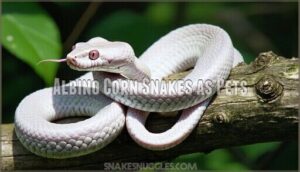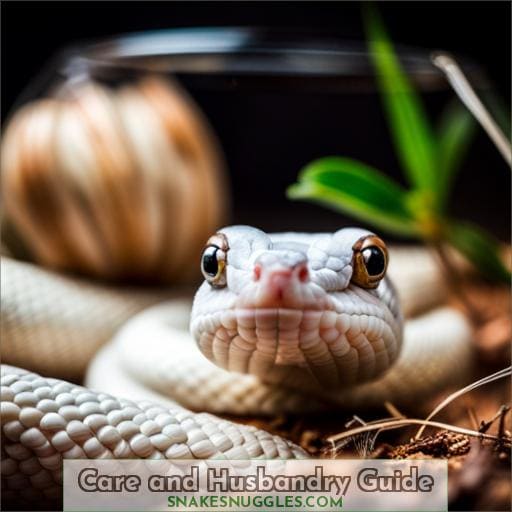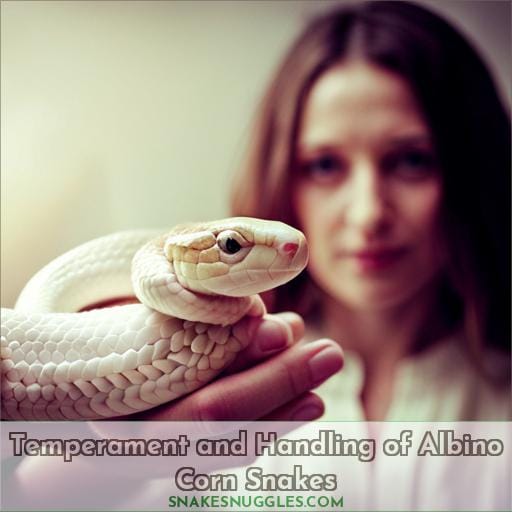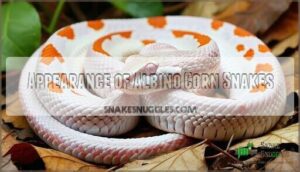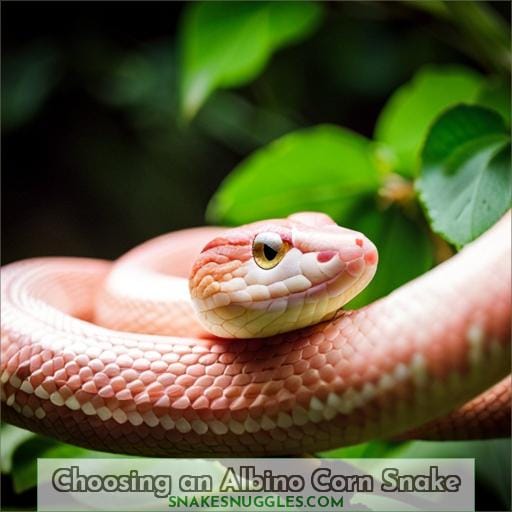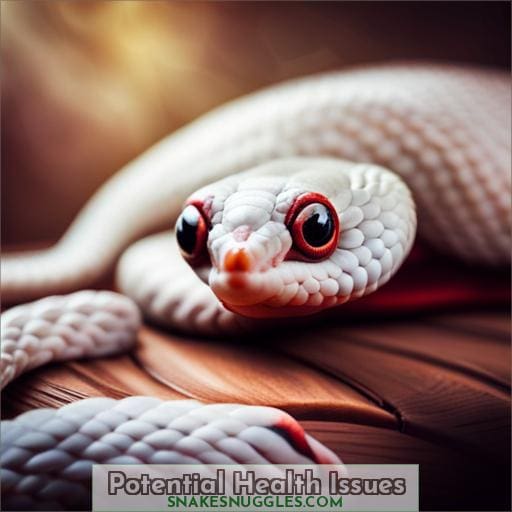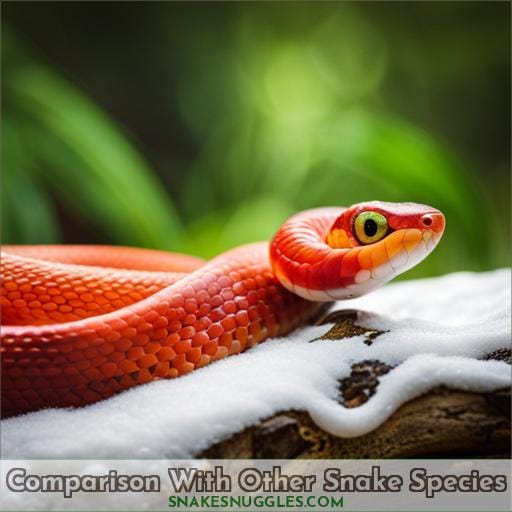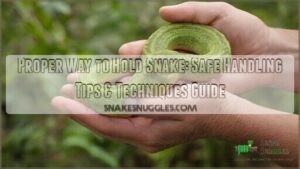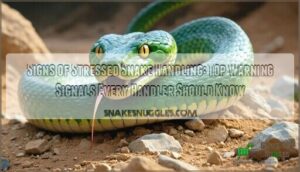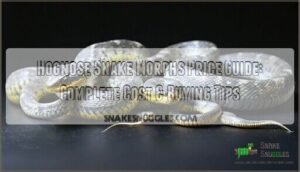This site is supported by our readers. We may earn a commission, at no cost to you, if you purchase through links.
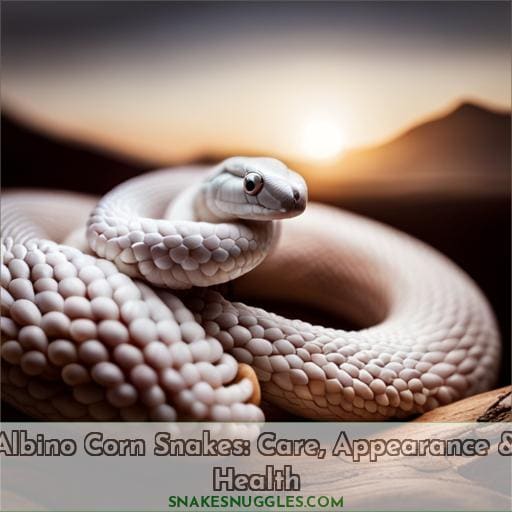 Immerse yourself in the world of Albino Corn Snakes and discover all there is to know about their care, appearance, and health. These captivating snakes are a popular choice for pet owners due to their docile nature and stunning colors.
Immerse yourself in the world of Albino Corn Snakes and discover all there is to know about their care, appearance, and health. These captivating snakes are a popular choice for pet owners due to their docile nature and stunning colors.
From setting up the perfect enclosure to understanding their nutritional needs, this comprehensive guide will equip you with everything you need to provide optimal care for your Albino Corn Snake companion.
Get ready to embark on an exciting journey into the realm of these fascinating reptiles!
Table Of Contents
Key Takeaways
- Proper care and husbandry are essential for the health and well-being of albino corn snakes.
- Feeding a suitable diet and monitoring for any health issues are crucial for their overall health.
- Albino corn snakes have specific handling requirements to ensure their safety and comfort.
- When choosing an albino corn snake, consider factors such as appearance, sex, and potential health issues.
Albino Corn Snakes as Pets
If you’re considering a pet snake, albino corn snakes make an excellent choice for beginners. These captivating reptiles come in various color morphs, adding a touch of uniqueness to your collection.
Breeding tips can be found from experienced breeders who specialize in producing different morph combinations that create stunning patterns and colors.
When it comes to handling techniques, albino corn snakes are generally docile and easily tamed with proper care and regular interaction.
To ensure their well-being, habitat simulation is crucial by providing them with the appropriate enclosure size, temperature gradient, hiding spots, and substrates that mimic their natural environment.
It’s important to note the differences between albino corn snakes and wild-type ones regarding appearance as well as health issues they may face due to genetic factors associated with albinism.
Care and Husbandry Guide
When it comes to caring for and maintaining the health of your albino corn snake, there are several important factors to consider.
First and foremost is providing the right housing and enclosure setup, ensuring that it replicates their natural environment.
Additionally, understanding their feeding and diet requirements is crucial for their overall well-being.
Lastly, being aware of common health issues that may arise will help you provide proper care and seek veterinary assistance when needed.
Housing and Enclosure Setup
To properly care for your albino corn snake, it’s essential to provide a suitable housing and enclosure setup.
- Choose an appropriate vivarium size, such as a 30-40 gallon glass tank for adults.
- Create temperature zones with heating pads or tape to maintain proper basking and ambient temperatures.
- Select the right substrate, like aspen shavings, that allows burrowing behavior while maintaining cleanliness.
- Incorporate climbing accessories and ensure humidity control through regular maintenance of the enclosure’s conditions.
Feeding and Diet
To ensure proper care and husbandry for your albino corn snake, it’s important to understand their feeding needs and diet.
- Albino corn snakes have dietary preferences that consist mainly of frozen-thawed rodents.
- Feeding frequency varies based on age, with hatchlings requiring more frequent feedings than adults.
- The size of the rodent prey should be appropriate for the snake’s age and size.
- Thawing techniques should be used to safely warm up frozen prey before feeding.
- Regular health monitoring is essential to identify any signs of illness or abnormal behavior in your albino corn snake.
Common Health Issues
Now let’s address the common health issues that can arise when caring for albino corn snakes.
Respiratory challenges may occur due to improper tank setup or environmental factors such as low humidity.
Shedding concerns are another issue, as inadequate humidity levels can lead to incomplete sheds and retained skin.
Dietary issues may arise if the snake isn’t offered appropriate prey sizes or a balanced diet.
Behavioral anomalies should also be monitored, such as abnormal aggression or excessive hiding, which could indicate underlying health problems.
Temperament and Handling of Albino Corn Snakes
When handling albino corn snakes, it’s important to approach them with patience and gentle confidence.
These snakes have a calm and inquisitive temperament, but they may exhibit defensive behaviors if they feel threatened.
To handle your albino corn snake safely and effectively, it’s crucial to understand their behavioral cues.
When the snake feels comfortable, you can start by gently sliding your hand underneath its body for support.
Avoid sudden movements or loud noises that could startle the snake.
Gradually lift the snake off the ground while supporting its entire body to prevent any stress or discomfort.
It’s advisable not to handle your albino corn snake during shedding periods as this can be irritating for them.
To tame an Albino Corn Snake or improve their socialization skills:
- Start with short handling sessions
- Use slow movements and avoid squeezing tightly
- Handle regularly but respect their need for rest
By using these techniques along with regular interaction tips such as feeding treats by hand or offering enrichment activities like hiding spots in a safe environment outside of their enclosure can help establish trust between you and your pet Albino Corn Snake.
Remember always wash hands before & after handling!
Appearance of Albino Corn Snakes
Take a look at the striking appearance of albino corn snakes.
These unique reptiles showcase a variety of color variations and morph combinations that make them visually captivating to snake keepers.
As an albino corn snake owner, you can expect to see vibrant hues such as white, pale red, or pale orange pigmentation on their scales. Their dorsal side features red saddles and orange banding, while their underbelly is white in color.
One fascinating aspect of these snakes is the genetic traits that result in different morphs within the albino category, including creamsicle, reverse okeetee, tessera, motley, and striped varieties. This means that each individual may have its own set of unique markings and patterns, making visual identification quite interesting for enthusiasts.
It’s truly remarkable how these genetic traits manifest into such stunning appearances!
Choosing an Albino Corn Snake
When choosing an albino corn snake, there are several factors to consider.
First, you’ll want to examine their appearance and coloration, as this can vary among different morphs of albino snakes.
Additionally, determining the sex of the snake is important for breeding or personal preference purposes.
Finally, it’s crucial to consider growth and size considerations when selecting a corn snake that will fit well within your living space and lifestyle.
Albino corn snake appearances
To choose the perfect albino corn snake for your collection, there are several key appearances you should consider.
Albino corn snakes come in various color morphs and pattern variations, making each one unique.
Their pigmentation patterns typically consist of white, pale red, or pale orange colors with red saddles and orange banding along the dorsal side.
Additionally, their visual traits include a white underbelly and striking red eyes due to their albino genetics.
Observations of these distinct appearances will help guide your decision when selecting an albino corn snake for your care.
Sexing albino corn snakes
To determine the sex of an albino corn snake, you can use a method called popping. This technique involves gently applying pressure to the vent area of the snake and observing its response.
Visual cues such as size differences or behavioral indicators may also aid in gender identification.
While there are no distinct visual markings that differentiate males from females, experienced breeders and reptile enthusiasts can often accurately identify the sex through these methods.
Growth and size considerations
When choosing an Albino Corn Snake, consider the growth and size of the snake to ensure it’s a suitable pet for you.
Take into account factors such as:
- Hatchling size
- Growth rate
- Adult size
- Maximum size
- Lifespan
Albino corn snakes typically start out as small hatchlings under 15 inches in length but can reach lengths of 3-5 feet by two years old. They’ve a slow and steady growth rate with an average weight ranging from 250-800 grams.
Potential Health Issues
Watch for signs of respiratory infections in your albino corn snake, such as wheezing or excessive mucus production.
Other concerning signs to look out for include:
- Long-term food refusal leading to drastic weight loss
- Frequent regurgitation after meals
- Abnormal breathing sounds like rasping or wheezing
- Discharge from the mouth or nostrils
- Skin lesions or discolored scales on the body and head region
- Mucousy or bloody diarrhea indicating gastrointestinal distress
Dehydration and overheating can also be detrimental to your snake’s health.
If you notice any of these symptoms in your albino corn snake, it’s important to seek veterinary care promptly as early intervention can greatly improve their chances of recovery.
Comparison With Other Snake Species
If you’re considering an albino corn snake as a pet, it’s important to know how they compare to other snake species.
-
Range and Distribution:
- Albino corn snakes are native to the southeastern United States.
- Eastern Cornsnakes (Pantherophis guttatus) have a broader range extending from New Jersey down to Florida and westward into Texas.
- Eastern Ratsnakes (Pantherophis alleghaniensis) can be found throughout eastern North America, including parts of Florida.
-
Habitat and Environment:
- Albino corn snakes prefer grasslands and forests as their natural habitat, with an ideal environment featuring a temperature gradient similar to their corn snake care requirements
.
- Eastern Ratsnakes occupy various habitats ranging from woodlands to farmlands.
- Albino corn snakes prefer grasslands and forests as their natural habitat, with an ideal environment featuring a temperature gradient similar to their corn snake care requirements
-
Predators and Prey:
- Both albino corn snakes and eastern ratsnakes feed on small mammals like mice or rats in the wild.
-
Behavior and Temperament:
- Albino corn snakes tend to exhibit docile behavior which makes them suitable for beginners as pets.
- Both eastern ratsnakes display similar temperament traits making them popular choices among reptile enthusiasts.
Frequently Asked Questions (FAQs)
How much do albino corn snakes typically cost?
Albino corn snakes typically cost between $40 and $60 USD.
The price may vary based on factors such as:
- Colorations
- Markings
- Sex
- Size
- Age
Reptile expos are recommended for face-to-face interaction with breeders to ensure a healthy snake.
Are albino corn snakes suitable for first-time snake owners?
Are albino corn snakes the perfect choice for first-time snake owners?
With their docile nature, striking appearance, and ease of care, these captivating serpents provide an ideal opportunity to experience the thrill of owning a snake.
What is the average lifespan of an albino corn snake?
The average lifespan of an albino corn snake is approximately 15-20 years when provided with proper care and husbandry.
With your dedication to their well-being, you can ensure a long and fulfilling life for your pet snake.
Can albino corn snakes be housed together with other snake species?
Yes, albino corn snakes can be housed together with other snake species as long as their size and temperament are compatible.
It’s important to research the specific needs of each species and provide adequate space and resources for all snakes in the enclosure.
Do albino corn snakes require any special lighting in their enclosures?
No, albino corn snakes don’t require any special lighting in their enclosures.
They can thrive with ambient room lighting and don’t have specific lighting needs like some other reptile species.
Conclusion
To conclude, this comprehensive guide has provided valuable insights into the world of Albino Corn Snakes.
By following the care and husbandry guide, you can ensure the optimal health and well-being of your pet snake.
Understanding their temperament and handling techniques will further enhance your bond with them.
Additionally, the guide has discussed the unique appearance of Albino Corn Snakes and provided tips for choosing the right one for you.
Overall, this article serves as an authoritative resource for anyone interested in owning an Albino Corn Snake.

